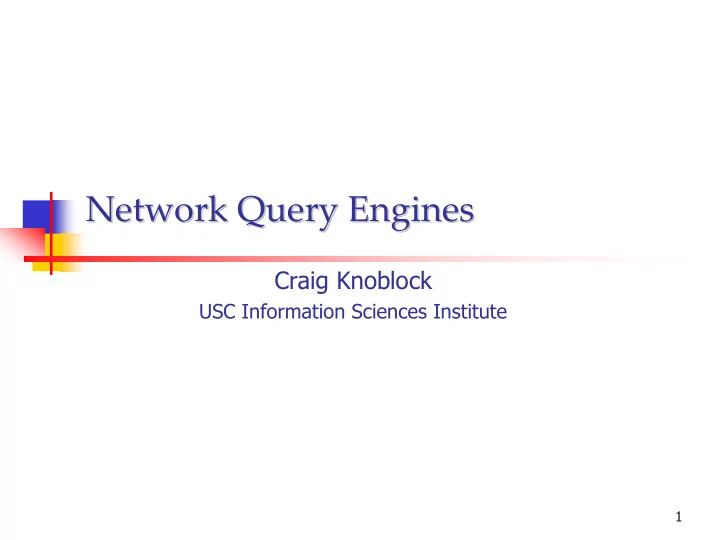

Network Query Engines Network Query Engines Craig Knoblock USC Information Sciences Institute 1
Overview Overview • Network Query Engines • Tukwila, Telegraph, Niagara • Dataflow & pipelining similar to Theseus • Execution system with support for efficient query execution from remote data sources • Automatically generate query plans from XML queries • No support for loops, conditionals, or external interactions • Designed for querying only, not monitoring (except for NiagaraCQ) USC Information Sciences Institute ISI ISI 2
Tukwila (Ives et al. 1999) Tukwila (Ives et al. 1999) • Adaptive network query processing for XML data • Interleaved execution and optimization • Inter-operator adaptivity • Dynamic operator re-ordering based on events • Memory overflow, wrapper timeout • Notable new operators • X-SCAN: Efficient querying of streaming XML docs • JOIN: Double pipelined hash (probe is LHS or RHS) • DYNAMIC COLLECTOR: Efficient unioning of sources USC Information Sciences Institute ISI ISI 3
Tukwila – – Interleaved Planning Interleaved Planning Tukwila and Execution and Execution From Ives et al., SIGMOD’99 • Generates initial plan Fragment 1 • Can generate partial Hash Join plans and expand Materialize them later & Test East • Uses rules to decide Hash Join when to reoptimize Orders FedEx Fragment 0 WHEN end_of_fragment(0) IF card(result) > 100,000 USC Information Sciences Institute ISI ISI THEN re-optimize 4
Tukwila – – Adaptive Double Adaptive Double Tukwila Pipelined Hash Join Pipelined Hash Join From Ives et al., SIGMOD’99 Hybrid Hash Join Double Pipelined Hash Join � No output until inner read � Outputs data immediately � Asymmetric (inner vs. � Symmetric outer) � More memory USC Information Sciences Institute ISI ISI 5
Tukwila – – Dynamic Collector Op Dynamic Collector Op Tukwila From Ives et al., SIGMOD’99 • Smart union operator • Supports C • Timeouts • slow sources • overlapping sources Cust NY alt.books Reviews Times WHEN timeout(CustReviews) DO activate(NYTimes), activate(alt.books) USC Information Sciences Institute ISI ISI 6
Niagara ( Niagara (Naughton Naughton, DeWitt, et al. 2000) , DeWitt, et al. 2000) • Adaptive network query processing for XML data • Interleaved execution + document search • Supports streaming over blocking operators • Synchronization by re-evaluating operators or by propagating the differential result USC Information Sciences Institute ISI ISI 7
Execution with partial results Execution with partial results [Shanmugasundaram Shanmugasundaram et al. 2000] et al. 2000] [ • Niagara uses partial results to reduce the effects of blocking operators • Reduces blocking nature of aggregation or joins • Basic idea • Execute future operators as data streams in, refine as slow operators catch up • Execution is driven by the availability of real data • Results are refined as additional data are processed USC Information Sciences Institute ISI ISI 8
Approaches to Refining Results Approaches to Refining Results • Re-evaluation • As new data becomes available, the operators re- output the results and the downstream operators are re-executed • Can be costly, but simple to implement • Differential Algorithm • Each operator must support additions, deletes, and updates • Changed results must then be propagated to downstream operators USC Information Sciences Institute ISI ISI 9
Telegraph ( Telegraph (Hellerstein Hellerstein et al. 2000) et al. 2000) • Tuple-level adaptivity • Rivers (optimize horizontal parallelism) • Adaptive dataflow on clusters (ie, data partitioning) • Eddies (optimize vertical parallelism) • Leverage commutative property of query operators to dynamically route tuples for processing USC Information Sciences Institute ISI ISI 10
Adaptable Joins, Issue 1 Adaptable Joins, Issue 1 • Synchronization Barriers • One input frozen, × waiting for the other 2000 • Can’t adapt while waiting 2 2001 3 for barrier! 2002 4 • So, favor joins that have: 2003 5 • no barriers 2004 6 • at worst, adaptable barriers USC Information Sciences Institute ISI ISI 11
Adaptable Joins, Issue 2 Adaptable Joins, Issue 2 • Would like to reorder in-flight (pipelined) joins • Base case: swap inputs to a join • What about per-input state? • Moment of symmetry: • inputs can be swapped w/o state management • E.g. • Nested Loops: at the end of each inner loop • Merge Join: any time* • Hybrid or Grace Hash: never! • More frequent moments of symmetry � more frequent adaptivity USC Information Sciences Institute ISI ISI 12
Ripple Joins: Prime for Adaptivity Adaptivity Ripple Joins: Prime for • Ripple Joins • Pipelined hash join (a.k.a. hash ripple, Xjoin) • No synchronization barriers • Continuous symmetry • Good for equi-join • Simple (or block) ripple join • Synchronization barriers at “corners” • Moments of symmetry at “corners” • Good for non-equi-join R • Index nested loops • Short barriers • No symmetry S × USC Information Sciences Institute ISI ISI 13
Beyond Binary Joins Beyond Binary Joins • Think of swapping “inners” • Can be done at a global moment of symmetry • Intuition: like an n-ary join • Except that each pair can be joined by a different algorithm! • So… • Need to introduce n-ary joins to a traditional query engine USC Information Sciences Institute ISI ISI 14
Telegraph – – Beyond Reordering Joins Beyond Reordering Joins Telegraph From Avnur & Hellerstein, SIGMOD 2000 Eddy • A pipelining tuple-routing iterator (just like join or sort) • Adjusts flow adaptively • Tuples flow in different orders • Visit each op once before output • Naïve routing policy: • All ops fetch from eddy as fast as possible • Previously-seen tuples precede new tuples USC Information Sciences Institute ISI ISI 15
Discussion Discussion • Theseus, Tukwila, Telegraph, Niagara are all: • Streaming dataflow systems • Targeting network-based query processing • Large source latencies • Unknown characteristics of sources • Proposed various techniques for improving the efficiency of processing data • More efficient operators (e.g., double-pipelined join) • Tuple-level adaptivity • Partial results for blocking operators • Speculative execution USC Information Sciences Institute ISI ISI 16
Recommend
More recommend